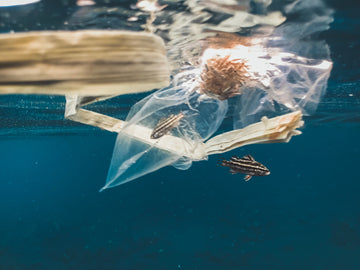Oceans cover more than 70% of the surface of our earth and are a natural wonder that is home to millions of species, while providing valuable resources for billions of people around the globe. Since the oceans are so vast, so much about them is unknown to humans. More than 80% of the oceans remain unexplored, leaving many questions unanswered. Because of this, there could be millions of extraordinary species still unknown to man and environments that we cannot comprehend. When it comes to our oceans, we really do not know the extent of the environment and our full impact on it.
As urbanization and industrialization continue to grow to further progress economies and standards of living, our oceans are being threatened by our constant need for more. The acts of countries, cities, corporations, and even the single individual have major effects on the beautiful oceans of our world. Today, they are being threatened like no other with overfishing, coral bleaching, pollution, depletion, sea level rise, and ocean acidification, and many other threats that will continue to harm the marine environment, unless we make major changes around the world.
What is overfishing?
Overfishing is the concept of depleting species populations to the point of little to no recovery. As commercial and industrial fishing has grown around the world to sustain the sheer number of humans now on the planet, fish stocks have drastically declined. There is a demand all over the world for seafood, especially for fish like tuna, salmon, and mahi mahi. As time has gone by, these animals are being fished to a point that is detrimental to their future. In some countries, sealife like sharks, whales, and dolphins are fished for their meat or flubber. These animals already don't have big populations since they only have one or two calves per year, so when they are caught or killed in large numbers, it is very difficult for their species to recover.
On top of getting intentionally fished, there is the constant threat of by-catch. This is when unwanted animals, oftentimes turtles, sharks, whales, dolphins, crabs, and even coral are unintentionally caught in fishing nets and traps. These animals are usually already dead when fishermen retrieve their nets or are fatally injured and left to die.
An overview of climate change and coral bleaching
Due to the release of carbon dioxide into the earth's atmosphere, we are seeing a temperature rise that is affecting both the earth’s geosphere and hydrosphere. The ocean absorbs about 30% of the carbon dioxide that is released and because of this, the pH levels are rising. When this happens, climate change occurs and the ocean becomes warmer, more acidic and less habitable, with certain species being able to withstand these changes more than others.
Coral is one animal that is particularly sensitive to changes in its environment. Ocean acidification, other aspects of climate change, pollution, sedimentation, extreme low tides, and other factors can cause coral bleaching. With these factors becoming more common, coral reefs are bleaching all over the world. There have been many global bleaching events. Recently, the third global bleaching event occurred between 2014 to 2017 and saw mass bleaching-level heat stress to more than 75% of reefs around the world, with nearly 30% also suffering mortality-level stress. Coral reefs are the backbone of the ocean providing food, protection, and homes to many different kinds of marine animals. When coral bleaching happens so often that corals do not recover and die, it affects other plants and animals that depend on it, thus affecting the health of the oceans as a whole.
The effects of pollution
Plastic pollution is not just isolated to landfills. It has taken over our planet and our oceans. Each year, eight million metric tons of plastic is dumped into the ocean. This plastic comes from many different places. One of the most obvious ways that plastic ends up in the ocean is through trash being left directly on or near beaches that get swept out to sea, but even trash far away from the coast can still make its way to the ocean through storm drains, rivers, and canals.
Some of the most common pollution found in the ocean include plastic and glass bottles, styrofoam cups, straws, and utensils, all items made for single use and convenience. These break down into microplastic, which is the most common size (less than 5mm) found in the ocean and easily eaten by animals. These plastics do the most damage because they can disperse very easily and are very hard to locate and clean up. A lot of these plastics come from waterways and end up in the ocean. Synthetic fabrics are a good example of this. Each time you wash your clothes, they shed tiny microfabrics that end up in the water in the washing machine, and drain into your local waterways and sewage systems and eventually into the ocean.
Another big contributor to plastic pollution is the disregard of materials from industrial and commercial fishing. The fishing industry uses giant fishing nets and other gear that commonly end up in the ocean either by accident or purposefully thrown overboard. Ghost nets in particular can drift for thousands of miles killing hundreds of animals in its wake. This is the main type of ocean waste that is recycled and spun into our bikinis.
Yet another type of pollution that is commonly overlooked is industrial pollution. Chemical runoff from power plants and factories play a big role in releasing toxic waste into the natural environment. Some of the biggest catastrophes that have severely affected the oceans and marine species are oil spills. Oil spills are a direct result of human impact on the environment and are usually caused by accidents involving drilling, pumping, and tankers. Because humans currently rely heavily on nonrenewable resources, extraction efforts take place all over the world and accidents directly harm the ocean.
Ways to make a difference
Although an extensive amount of damage has already been done to our oceans, it doesn't mean there’s no other way. We can all do our part and change our own habits to protect and lower the impacts to the oceans over the years to come. Becoming aware of threats to the ocean is the first step. Because we know so much plastic pollution ends up in the ocean, we can use this information to help reduce our own plastic usage.
A small first stem is to always deny single use plastic such as cutlery, take out containers, straws, and plastic bags. Instead of getting your morning coffee in the usual plastic cup, bring your own cup and reusable straw from home. When getting takeout, you can deny the plastic utensils provided and wait to get home where you can use your own reusable fork and knife. Another important step you can take is taking the time to learn about where you are buying from and what businesses you are supporting. Is the product ethically manufactured? What materials are used? What kind of packaging does this come in? There is so much information online about what businesses across all industries are doing and which are leaders in sustainability. In today's world, customers have the loudest voice. If enough people stop buying from unethical and unsustainable companies, they will be forced to change their ways.
To read up on the eco-friendly materials and practices we use and how we are trying to make a difference in the fashion industry, please visit our Sustainability page and blog.






